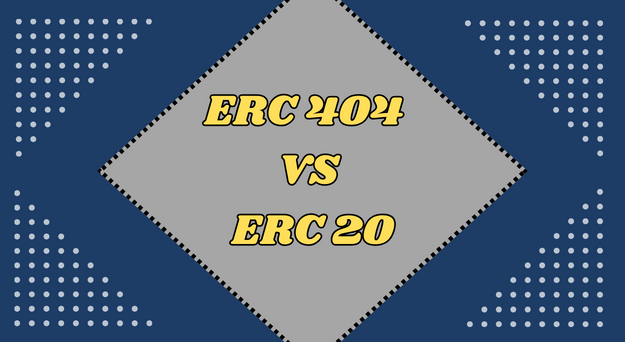ERC-404: Unveiling the Next Frontier in Token Standards
What Is ERC-404: ERC-404 emerges as an experimental Ethereum token standard, seeking to revolutionize the interaction between fungible and non-fungible tokens (NFTs). Conceived under the project name Pandora, ERC-404 pioneers a hybrid approach, combining elements from both ERC-20 and ERC-721 standards.
History of ERC-404: Born out of the need for a more versatile token standard, ERC-404 was created by pseudonymous developers known as “ctrl” and “Acme” and introduced through the Pandora project. Its inception marks a step toward addressing the limitations of existing standards in the dynamic and ever-expanding blockchain landscape.
ERC-404 Contents: While ERC-20 specifies a set of functions that facilitate the creation and management of fungible tokens, ERC-404 introduces novel functions tailored to the fusion of fungible and non-fungible assets. These functions aim to enable fractionalized NFT collections that can be freely traded and utilized in open markets.
Key ERC-404 Functions and Events:
mint()– Create new ERC-404 tokens.transfer()– Facilitate the transfer of ERC-404 tokens.approve()– Grant permission for another address to spend ERC-404 tokens.fractionalize()– Convert ERC-721 NFTs into ERC-404 tokens.trade()– Enable the trading of fractionalized NFT portions.
What Does ERC-404 Mean: ERC-404 represents a bold exploration into uncharted territory, challenging the conventional boundaries between fungible and non-fungible tokens. By attempting to seamlessly integrate the strengths of ERC-20 and ERC-721, ERC-404 opens the door to innovative use cases, including the creation of fractionalized NFTs with shared ownership.
Difference Between ETH and ERC-404: While Ethereum (ETH) is the native cryptocurrency of the Ethereum blockchain, ERC-404 operates as a token standard built on Ethereum. ETH is fungible and serves as the primary medium of exchange on the Ethereum network. ERC-404, on the other hand, introduces a hybrid standard that combines the characteristics of ERC-20 and ERC-721, fostering a unique ecosystem for fractionalized NFTs.
Bottom Line: ERC-404 signifies a pioneering attempt to redefine token standards and foster new possibilities within the Ethereum ecosystem. As an experimental standard, it encourages developers and users to explore the uncharted territory of combining fungible and non-fungible tokens. While challenges and security concerns may accompany such experimentation, ERC-404 represents a testament to the continuous innovation within the blockchain space and the ongoing evolution of decentralized technologies.
Unveiling the Evolution: ERC-20 vs. ERC-404
The Ethereum blockchain, renowned for its transformative capabilities, has been a hotbed of innovation in the realm of token standards. Two standards that have recently sparked considerable interest are ERC-20 and the experimental ERC-404. Let’s dive into a comprehensive comparison to understand the nuances and distinctive features that set these standards apart.
ERC-20: The Fungible Pioneer
What Is ERC-20: ERC-20, a stalwart in the Ethereum ecosystem, is a token standard that has been instrumental in the proliferation of decentralized applications (DApps) and the tokenization of various assets. It defines a set of rules and functions facilitating the creation and management of fungible tokens on the Ethereum blockchain.
History of ERC-20: Introduced in 2015, ERC-20 brought standardization to Ethereum-based tokens, promoting interoperability and facilitating the development of a myriad of decentralized financial applications. Its inception marked a turning point in the decentralized finance (DeFi) landscape.
ERC-20 Contents: The ERC-20 standard includes essential functions such as totalSupply(), balanceOf(), transfer(), approve(), and events like Transfer and Approval. These functions have become the backbone of countless tokens, enabling seamless interaction within the Ethereum ecosystem.
What Does ERC-20 Mean: At its core, ERC-20 signifies a standardized approach to fungible tokens, ensuring compatibility across various applications, wallets, and exchanges. It has become the go-to standard for token creation, powering a diverse array of use cases, including digital currencies, stablecoins, and utility tokens.
Difference Between ETH and ERC-20: It’s vital to distinguish between Ethereum’s native cryptocurrency (ETH) and tokens adhering to the ERC-20 standard. ETH serves as the primary currency on the Ethereum network, while ERC-20 tokens, fungible in nature, represent a spectrum of assets and utilities within the Ethereum ecosystem.
ERC-404: Bridging Fungibility and Non-Fungibility
What Is ERC-404: In contrast to the well-established ERC-20, ERC-404 is an experimental Ethereum token standard, seeking to redefine the interaction between fungible and non-fungible tokens. Introduced through the Pandora project, ERC-404 combines features from ERC-20 and ERC-721, introducing a hybrid approach.
History of ERC-404: ERC-404 is a nascent entrant, born out of the necessity for a more versatile standard. Pseudonymous developers “ctrl” and “Acme” initiated this project, aiming to address limitations and unlock new possibilities in the evolving blockchain landscape.
ERC-404 Contents: The ERC-404 standard introduces novel functions such as mint(), fractionalize(), and trade(), enabling the creation and trading of fractionalized NFTs. While experimental, these functions showcase ERC-404’s ambition to blend the strengths of ERC-20 and ERC-721 seamlessly.
What Does ERC-404 Mean: ERC-404 represents a bold exploration, challenging the traditional boundaries between fungible and non-fungible tokens. It opens the door to fractionalized NFTs, allowing multiple wallets to own portions of a single NFT, fostering new use cases and shared ownership models.
Difference Between ETH and ERC-404: While ETH remains the native cryptocurrency of Ethereum, ERC-404 operates as a token standard built on this blockchain. ETH is fungible and serves as the primary medium of exchange, whereas ERC-404 introduces a hybrid standard for fractionalized NFTs, aiming to redefine the landscape of shared ownership.
Bottom Line: Navigating the Landscape of Token Standards
In conclusion, both ERC-20 and ERC-404 contribute to the rich tapestry of Ethereum token standards, each with its unique strengths and applications. ERC-20 stands as a reliable and well-established choice for fungible tokens, powering a vast array of decentralized applications. In contrast, ERC-404 ventures into experimental terrain, presenting a hybrid approach that merges the best of fungible and non-fungible worlds.
As the Ethereum ecosystem continues to evolve, these token standards exemplify the ongoing spirit of innovation, challenging developers and users to explore new horizons in the decentralized realm. Whether navigating the proven paths of ERC-20 or embracing the experimental frontier with ERC-404, the Ethereum community remains at the forefront of shaping the future of blockchain technology.

Leave a Reply